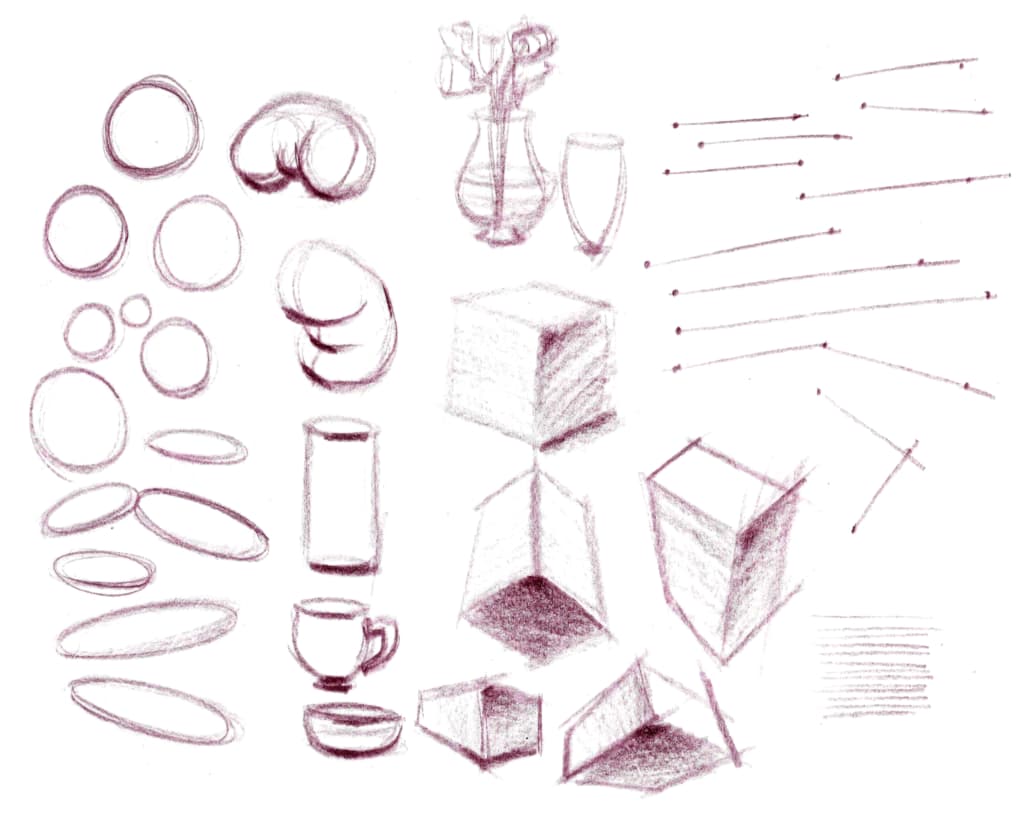Incorporating drawing warm-up exercises into one’s artistic routine can profoundly impact the quality and precision of artwork. Often, the initial sketches in a drawing session may lack the desired sharpness or accuracy, improving gradually as the artist continues. To mitigate this, beginning with targeted warm-up exercises can significantly enhance the overall drawing quality from the start. These exercises are designed not just to prepare the hand and eye for drawing, but also to mentally prime the artist for the creative process ahead.
The Importance of Warm-Up Exercises in Art
Initiating a drawing session with warm-up exercises is a crucial step for artists. These exercises serve to sharpen focus, enhance hand-eye coordination, and ensure that the artist’s mental vision is accurately translated into the drawing medium. Much like athletes who warm up before a performance, artists benefit from these exercises as they prepare both the mind and body for the intricate task of drawing.
Optimal Duration for Effective Warm-Ups
The length of time dedicated to warm-up exercises can vary based on the artist’s experience and comfort level with drawing. A minimum of 5 minutes is recommended for seasoned artists, while those newer to the art form or seeking to refine their skills might extend their warm-up to 10 minutes or more. This time allows for a gradual build-up of drawing proficiency, ensuring a smoother transition into more complex artistic work.
Criteria for Selecting Warm-Up Exercises
Selecting the right warm-up exercises is pivotal for an effective drawing session. The exercises should be straightforward, focusing on basic forms and movements without being overly complex or challenging. They should ideally engage both the mind and muscles, creating a synergy that prepares the artist for the act of drawing. A series of short, simple exercises can effectively ease the artist into the drawing session, making the transition into more detailed work comfortable and natural.
Detailed Exercise 1: Practicing Straight Lines
A fundamental exercise involves practicing straight lines. Artists should start by marking two points and connecting them with as straight a line as possible. This exercise is crucial for developing steady hand control and line accuracy, essential skills in drawing. Repeating this exercise at different angles helps the artist achieve perfect linearity. For artists who practice daily, muscle memory plays a significant role, allowing for the creation of straight lines with ease and precision from the very first attempt.
Detailed Exercise 2: Drawing 2D Shapes
The next step involves drawing basic 2D shapes like circles, squares, or triangles. Each repetition should vary the size of the shape, challenging the artist to maintain accuracy and proportion. This exercise is particularly effective in enhancing spatial awareness and precision, critical skills in the art of drawing.
Detailed Exercise 3: 3D Shape Practice
Progressing to 3D shapes, such as cubes or spheres, is an excellent way to develop an understanding of volume and perspective. Artists should practice drawing these shapes in various sizes and from different angles, enhancing their ability to perceive and depict three-dimensional forms accurately.
Detailed Exercise 4: Swirl Drawing Technique
Creating swirls is a unique and enjoyable warm-up exercise. Unlike more familiar shapes like lines and squares, swirls require a different set of movements and control. This exercise not only stimulates creativity but also provides a good physical warm-up for the shoulder and arm, reducing stiffness and enhancing fluidity in drawing.
Detailed Exercise 5: Sphere Drawing
Drawing spheres is a versatile exercise, beneficial for artists who frequently sketch human figures, portraits, or scenes from real life. Spheres form the base of many real-life objects, and mastering their depiction is crucial for realistic drawing. This exercise serves as an excellent introduction to more detailed drawing sessions.
Detailed Exercise 6: Advanced 3D Shapes with Cuts
For more experienced artists, drawing 3D shapes with cut-out sections presents a challenging yet rewarding exercise. This task requires a deeper understanding of spatial relationships and the ability to visualize and draw complex forms. It is particularly beneficial for artists striving to master drawing from imagination, as it enhances their spatial and form perception skills.
Detailed Exercise 7: Building Muscle Memory
To develop muscle memory, artists should draw a series of shapes in their usual manner and then attempt to draw them in reverse order. This unconventional method, akin to drawing with a non-dominant hand, challenges the artist’s adaptability and skill, leading to greater versatility in drawing.
Bullet Points: Summary of Exercises
- Straight Line Practice: Enhances hand steadiness and line control;
- 2D Shape Drawing: Improves spatial awareness and accuracy;
- 3D Shape Practice: Develops understanding of volume and perspective;
- Swirl Drawing: Stimulates creativity and physical fluidity;
- Sphere Drawing: Builds foundational skills for realistic drawing;
- Advanced 3D Shapes with Cuts: Challenges spatial perception and complexity;
- Muscle Memory Building: Increases adaptability and drawing versatility.
Comparative Analysis: Warm-Up Exercises vs. Full Drawing Sessions
| Aspect | Warm-Up Exercises | Full Drawing Sessions |
|---|---|---|
| Focus | Basic forms, movements, and control | Detailed, complex artistic works |
| Duration | Short, typically 5–10 minutes | Extended, often hours |
| Complexity | Simple, fundamental exercises | Intricate, requiring advanced skills |
| Objective | Preparation for detailed work | Creation of complete artwork |
| Skill Development | Basic hand-eye coordination, focus | Advanced techniques, creativity |
Video Guide
In order to answer your questions in more detail, we have prepared a special video. Enjoy watching it!
Conclusion
In conclusion, drawing warm-up exercises plays a vital role in an artist’s routine, serving as the foundation for successful and intricate artwork. These exercises, ranging from simple line drawing to more complex shape creation, are essential for developing focus, hand-eye coordination, and muscle memory. Regular practice of these warm-up routines not only prepares the artist for the physical act of drawing, but also primes the mind for creative expression, making them an indispensable part of any artist’s daily practice.
